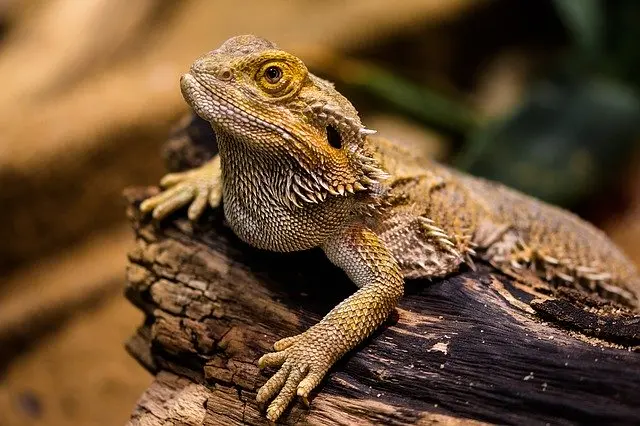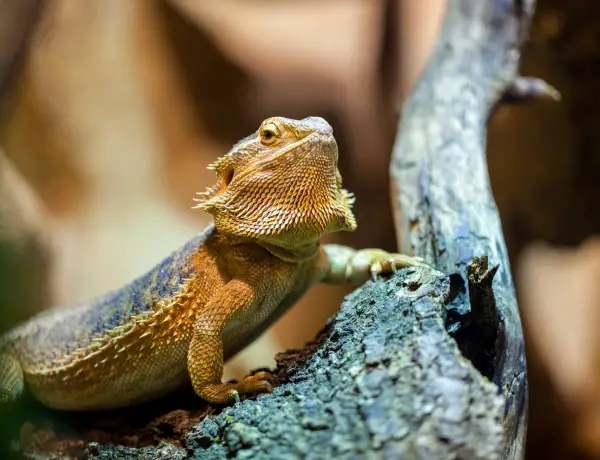Bearded dragons may have originally come from the Australian outback’s deserts, but just like any other animal, they need water too. In providing this much-needed nourishment for them, is it ok if your bearded dragon drinks tap water, or should you give them bottled water? Let’s find out!
If you have good clean well water, it can be safe to give them tap water. Other types of water may contain fluoride, chlorine, chlorimides, and varying minerals that could be unhealthy or fatal for your bearded dragon. If your water has these additives in it, you are better off putting water conditioner in the water before giving it to them – or giving them filtered bottled water.
Keeping in mind that not all water is created equal, even with bottled water, there are some types that you may want to steer clear of. While bearded dragons don’t always consume copious amounts of water, it is still a necessity for them. Giving them the wrong type of water can prove disastrous to their health.
Table of Contents
What Kind of Tap Water is Safe for a Bearded Dragon?
If you live somewhere that has exceptional well water, without an overabundance of certain minerals present, it can be safe. Bearded dragons, especially when they are young, may benefit from a little extra calcium if it is present in your water supply. Other minerals that can be found in some areas, such as an abundance of phosphorus, iron, or sulfur, have the potential to cause some harm to them.
You can get groundwater reports from the EPA if you are unsure of the water’s conditions around your locale. After checking your water, if you are still uncertain whether your water could be safe or harmful for your beardie, I would recommend playing it safe and using a water conditioner. Reptisafe is relatively inexpensive and specifically made for reptiles. Other brands should work as well; I only recommend this brand because the additional electrolytes in it will help their skin at the same time, and the company has an outstanding reputation.
Can I Use Tap Water In My Beardies Tank?

Since bearded dragons may drink from the water they play or bathe in, the same restrictions they had for drinking water should still apply for water they can sit or play in. You should make sure that the water is safe. You don’t want any chlorine or overabundance of minerals in it. Remember that just because water is relatively safe for you to drink, does not mean that it is for your beardie.
Again, if you are in doubt about the water quality in your beardies tank, use bottled water or a water conditioner. Which one you use is up to you, you may want to price the cost of the conditioner versus buying bottled water and how often you go through it.
While some people believe that bearded dragons absorb water directly through their skin, that’s not actually the case. Another popular myth you may have heard is that bearded dragons can absorb water up from their “vent,” also known as their cloaca. Their vent is the same area they pee and poop from. For years, this was believed to be correct; however, several studies lately wholly debunked this myth. This theory is also why it was popular to assume they always defecated in or soiled their water in some fashion.
While it’s true that it is not uncommon for a beardie to urinate or defecate in their water dish or bathtub, some bearded dragons are far “dirtier” than others. The ones that are more likely to exhibit this behavior will need their water changed out in their tank more frequently than the ones that do not. If your beardie isn’t keen on soiling its water, you can usually get away with changing it once each morning.
Bottled Water Vs. Tap Water For Your Bearded Dragon
If you don’t have great tap water or are on municipal water where they add chlorine, fluoride, or other kinds of chlorimides, you will have to use a water conditioner. Not doing so can be harmful to your beardie. Even though the bottles of water conditioner will last you quite a while, you may want to look into bottled water instead. It’s a good thing to know which bottled water you should get anyway, just in case the need arises at some point.
If you go with bottled water, make sure it is filtered, not purified or distilled. This goes for whether it is drinking water, tank water, or even the water in your misting bottle. What’s the difference in the bottled water, you ask? Let’s take a look:
- Mineral Water – Mineral water is just what it sounds like. It contains minerals. Generally, those minerals are iron, sulfate, calcium, magnesium, and potassium. These dissolved solids are present to about 250 ppm or (250 parts-per-million.) If using mineral water, you may still want to add some water conditioner to it.
- Spring Water – This is water from a natural spring, typically collected through a borehole, then filtered after it is collected. This type should be a safe type to use, but be sure to check the label as some nefarious companies make it look like spring water when that segment is just part of their brand name and its really plain tap water.
- Purified Water – Purified water refers to the number of mineral solids; for it to be labeled as such, it has to be under ten ppm. Several processes can be used for this, including reverse osmosis distillation, or ion exchange.
- Distilled Water – Distilled water is actually the same thing as purified water; it just undergoes a different process. It has the lowest amount of minerals present, sitting at around one ppm. The problem with distilled water is that while the minerals will be filtered, some chemicals will vaporize along with the water. So when they collect the water afterward, the chemicals are still present.
- Filtered Water – Filtered water is generally from a municipal tap somewhere, but they have used carbon filters on it to catch most of the chlorine and other contaminants. After they filter it, they will usually ozonate it before putting it into bottles. This type is typically the closest you will get to spring water.
What Kind of Bottled Water Should I Give My Bearded Dragon?
To err on the side of caution, I would recommend giving them either spring water or filtered water. The processes with which distillation and purifying water take place are safe for the most part. However, with the different chemicals that may be present still after the procedure, such as benzene and toluene, I wouldn’t use them unless I did not have a choice.
In the grand scheme of things, they ultimately do not go through water that fast. So play it safe and go with something you know won’t potentially harm your beardie friend.
How Much Water Does My Bearded Dragon Need?

I mentioned at the beginning that bearded dragons are native to the deserts in Australia. You would be correct in assuming there isn’t much water to go around most times of the year. While in the desert, they tend to consume a lot of water during the few times a year that it would rain, the rest of the time, they would stay hydrated by getting water from the bugs and plants they would consume.
Being raised in a tank is much different from living in the desert, however. The temperature, humidity, access to bugs, and other things are different than those in your home. Because of this, they need more water access than they traditionally have in their native environment.
They should have a fresh and clean supply of water every day, preferably in containers that they can not easily tip over.
If your beardie does not drink out of a tub, you can also try something like this big dripper. While it is possible to train your bearded dragon to drink from a tub, they have a hard time seeing water that isn’t moving. The drip on this will simulate rainfall droplets, and also give them access to fresh, clean water that they cannot contaminate. It would be best if you still had a tub that you change out and disinfect each day for them to bathe or play in.
For misting, you can typically do it once or twice per day, but sometimes up to as many as four times a day. If you live in a relatively dry environment, you may want to increase the frequency in which you mist them. Don’t forget that in the wintertime, the air can become much less humid than usual. By misting your beardie, you are raising the humidity in their tank some and helping them shed. One thing to be careful about is that you want to be sure to keep an eye on the humidity in their tank. If you raise the humidity levels too much, it may cause an influx of bacterial or fungal growth.
Ultimately, make sure that your bearded dragon has access to fresh, clean water daily, no matter which type of water you choose to use. If you are in doubt of the chemical additives in the water, add some water conditioner to it to be safe. Just make sure you follow the instructions and don’t add too much of it.




